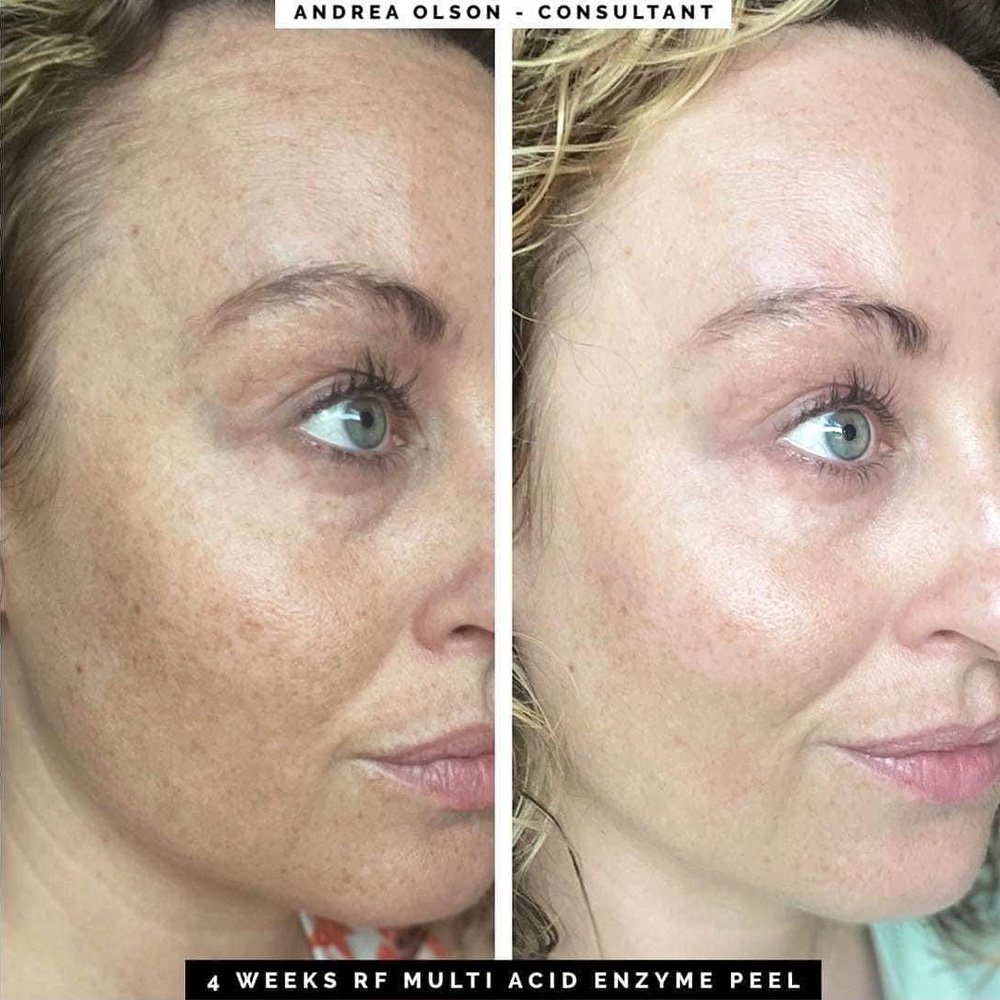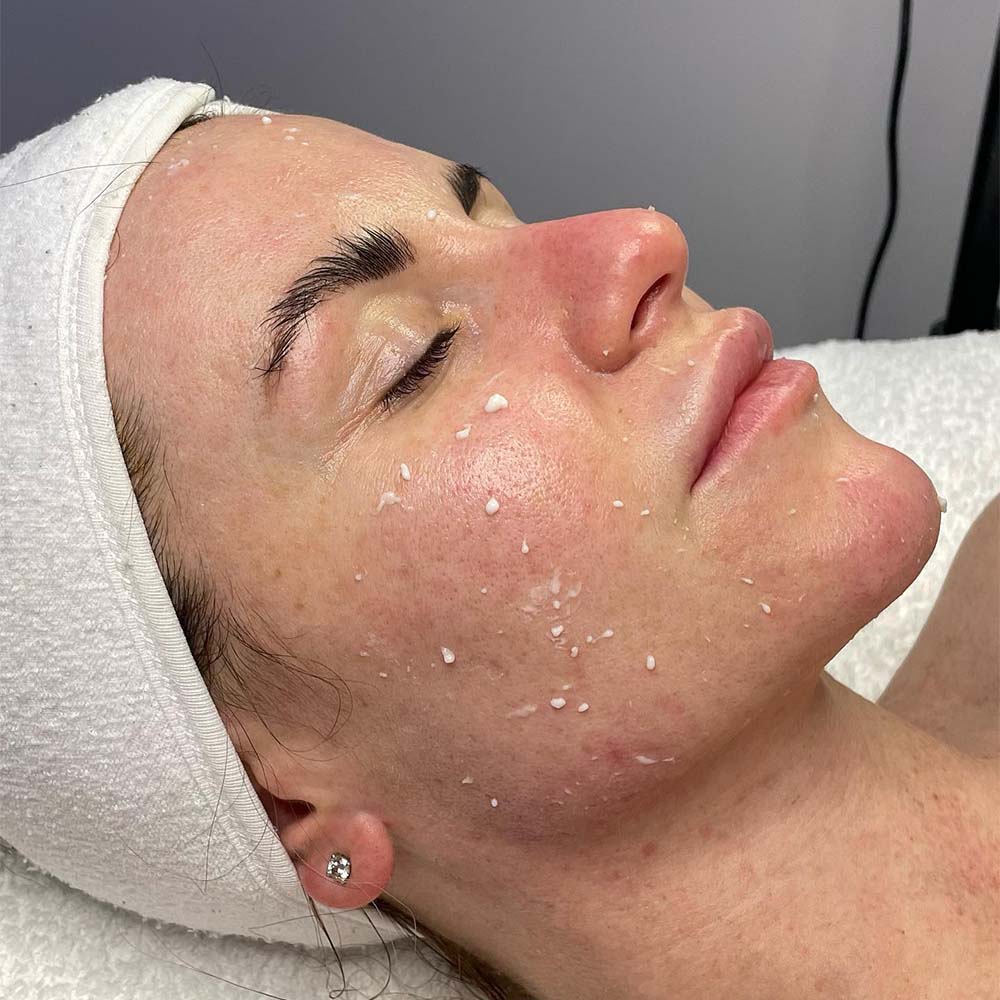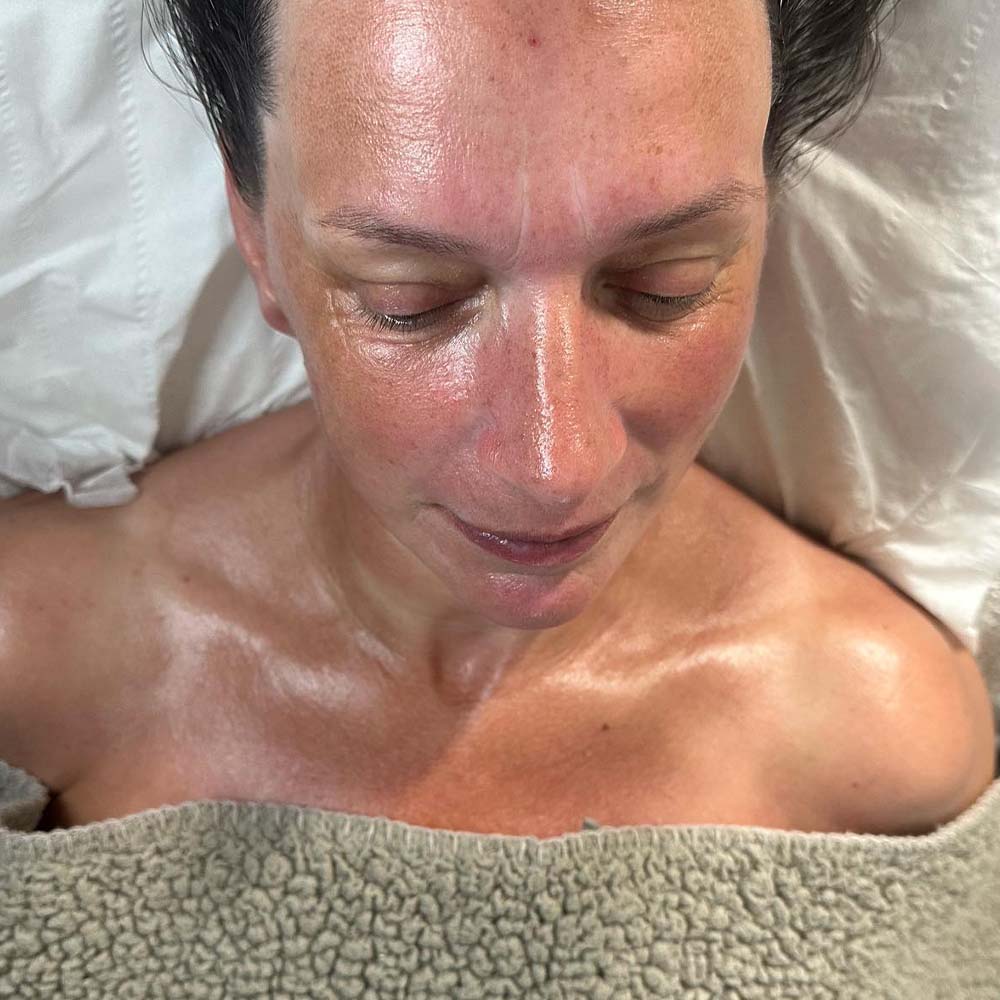Enzyme Peel: The Ultimate Guide
Here’s all you need to know about the enzyme peel treatment: effects, process, before & afters, and how to do it at home.

Image source : PMUhub
Enzyme peel is an exfoliating treatment that uses real fruit enzymes to reveal healthy, radiant skin. The enzyme facial is commonly suggested as a substitute for other much stronger chemical acid peels.
Due to the more gentle nature of enzyme peel facial, it’s an excellent option for those with more sensitive skin types who still want to achieve a similar result without damaging their skin barrier.
Let’s find out whether this treatment is the right option for you and what are the different ways to do it.
What Is an Enzyme Peel?
An enzyme peel is an exfoliating facial treatment, meant to remove dead skin cells from the surface of your skin and reveal new, glowing skin.
The enzymes used in enzyme peels come from fruits and vegetables such as pineapple, papaya, and pumpkin.
They’re applied to the face as a mask or a scrub.
These proteolytic enzymes help to break down proteins in the outer layer of the skin. This helps dead skin cells come off, leaving the skin smoother and softer, with fewer discolorations.
It’s a safe, natural, and effective treatment which makes it the perfect mild exfoliant for those who have sensitive skin, and who don’t react well to stronger ingredients.
Most Popular Fruit Enzyme Peel Options
Here is the list of different fruit and vegetable enzyme mask options and their specific characteristics:
Pumpkin Peel
Pumpkin is full of AHA’s as well as B vitamins and minerals like niacin and zinc which helps to control oil production. That makes it a great choice for people with acne-prone skin to safely target breakouts without causing irritation.
Papaya Enzyme Peel
Papaya is one of the most commonly used fruit enzymes. It increases skin elasticity and prevents fine lines from forming. Perfect for pigmented and dull skin, as it has amazing brightening properties.
Banana Enzyme Peel
Banana contains amylase and maltase enzymes so it’s perfect for dissolving dead skin cells and nourishing dull and dehydrated skin. It’s perfect for revitalizing dry skin, controlling sebum production, and reducing breakouts.
Passionfruit Peel Enzyme
Passionfruit has the catalase enzyme that works by digesting dead skin cells and removing sebum, which is why it’s often used to help with clearing congested and acne-prone complexions. It is also an excellent antioxidant, which will give your skin a dewy glow.
Enzyme Peel VS. Chemical Peel – What’s the Difference?
You might be wondering, is an enzyme peel a chemical peel? The answer is no. Enzyme peels don’t use any harsh chemicals and don’t remove any live skin cells from your face.
But, some enzyme peel products might contain a reduced concentration of acids found in chemical peels. If you want to avoid these acids entirely, disclose that to the technician prior to the procedure.
Although you can definitely expect a noticeable difference with the enzyme peel facial, the biggest advantage chemical peels have over this treatment is their ability to improve more significant skin concerns like signs of aging, hyperpigmentation, or acne scarring.
Since the enzyme peel is not as strong as chemical peels, the results are also not as intense or long-lasting, unfortunately. You can learn more about chemical peels’ process, benefits and results here.
It will take you several enzyme peel treatments to achieve the same result that you’ll see with a single chemical peel – meaning enzyme peels will still get the job done but will require more time and effort.

So What Does an Enzyme Peel Do?
You might be wondering what are the enzyme peel results and whether this procedure is a worthy investment or not. Enzyme peel benefits include:
- Increased collagen production, which improves skin texture and helps with fine lines and wrinkles as well as scars and redness
- Boosts skin hydration giving you a more plump and luminous skin
- Unclogs and shrinks pores
- Doesn’t irritate the skin
- It works for all skin types, including sensitive skin
- It’s even safe for pregnant women
As you can see, this facial works for anyone, but it’s specifically great as an alternative for those who can’t handle other facials such as microdermabrasion, or laser resurfacing treatments.

What Conditions Are Fruit Enzymes Used For?
Essentially, this treatment is good for everybody. Since it’s not too harsh it can be done more frequently, and it has lots of benefits for a milder exfoliant.
Enzyme Peel for Acne
Since a lot of facials – chemical peels and otherwise – can’t be done over active acne, you’re probably wondering are enzyme peels good for acne? The answer is yes!
If you have acne, enzyme peel facial can help calm down the inflammation and reduce excess sebum production.
Just make sure to consult with a dermatologist before booking the procedure, so you don’t exacerbate the problem.
Enzyme peel also helps to reduce the look of large pores and blackheads, which usually come together with acne, so that’s another bonus.
Enzyme Peel for Hyperpigmentation
The benefits of an enzyme peel are similar to those of a chemical peel. Among other things, it can help fade hyperpigmentation and even out your skin tone.
Over time, you will have removed discolorated layers so you just need to be patient and consistent.
Enzyme Peel for Fine Lines and Minor Wrinkles
By removing the layer of dry, flaky skin, enzyme peel facial helps your complexion appear less dull and much more youthful. On top of that, brightening and visible pore reduction also aids in more radiant and rejuvenated skin.
Enzyme Peel for Body
Enzyme peels can be used on the body as well, so any area that is safe for using exfoliants such as the back or chest, can be treated with this peel. Many people use enzyme peel to exfoliate dark underarms, elbows and even on stretch marks.
Enzyme Foot Peel
Fruit enzymes remove the layer of dead skin, so obviously this makes them a great peeling treatment for feet. You can find products that are made specifically for this area and are very effective.
How to Prepare for an Enzyme Peel Facial
Since this exfoliating treatment is less intense than some other peels, it does not require any special preparation on your side.
But it would be good to skip wearing makeup for a couple of days before your appointment, to make sure your pores are as clean as possible.
You also want to avoid tanning or going to tan in sunbeds as that will increase your skin’s sensitivity. And make sure you don’t have any open wounds that could get irritated and inflamed during the enzyme peel.
What Does the Professional Enzyme Peel Look Like?
Depending on what clinic you go to, there are different ways an enzyme peel can be done.
You will find that a lot of enzyme products are in the form of a physical scrub, or as powders that need to be mixed with a liquid and applied as a mask. Whichever method you choose, the process is pretty similar.
First the technician will clean your face, then apply the product and wait for the recommended amount of time, according to the instructions.
The exact application time varies depending on the strength of the enzyme peel and the individual’s skin sensitivity.
After the peel is removed, the technician will also apply a moisturizer and sunscreen – or continue the facial if there are more add-ons steps.
What to Expect After the Enzyme Facial
The enzyme peel is very effective in what it does and delivers great results even after the first treatment. You will notice a result of smoother, glowing skin without any downtime.
Enzyme Facial Aftercare
A great benefit that an enzyme facial has that chemical peels don’t is that there’s little to no downtime or recovery involved after, since they typically work without damaging or irritating your skin.
So there is very minimal aftercare needed, but it would be good to avoid sun rays as much as you can, and of course, make sure to keep your skin protected by wearing lots of SPF.
The one enzyme peel side effect you might experience is some mild tingling and potentially slight redness, but you can continue with your normal daily routine right away.
Is Enzyme Peel Safe?
Since this procedure is a mild exfoliating treatment, it is considered safe for the majority of people.
Risk and side effects are mostly related to skin irritation of allergic reactions – both of which are easily preventable with a patch test.
Still, just like with any facial, consult your technician about any contraindications you might have to determine whether it’s safe – especially if you experience acne, dermatitis, or herpes outbreaks.
How Much Is the Enzyme Peel Price?
The relative affordability of this facial is another great benefit that makes it a good option to consider instead of a chemical peel.
Professionally done enzyme peel prices can range anywhere from $100 to $200, depending on the products used and the clinic where you get it done.
But if you’re more of a do-it-yourself kind of person, you’ll be happy to know there are tons of at-home enzyme peelings starting as low as $14!
Can You Do Enzyme Peel At Home?
Yes. Enzyme peel is a less intense exfoliating peel and therefore it’s safe to do it at home by yourself.
So if you like the sound of all of these effects and benefits that the enzyme peels provide, but you would prefer a good at-home option, don’t worry, we got you covered.
You’ve read earlier which fruit enzyme is the best for what skin condition, so now you’re ready to choose the perfect product for you.
Best Enzyme Peel At-Home Options
As mentioned before, this peel contains enzymes derived from different fruits and vegetables, that all have their own benefits and skin conditions they work on the best.
Papaya Enzyme Peel at Home
A great option is Elemis Papaya Enzyme Peel. This gentle exfoliator contains natural enzymes from papaya and pineapple which help in dissolving dead skin cells without abrasion, leaving the skin looking and feeling smooth, revitalized, and radiant.
Pumpkin Enzyme Peel
If you think that pumpkin would be the best option for your skin’s needs, then check out this Peter Thomas Roth Pumpkin Enzyme Mask. This enzyme face mask helps address the appearance of a dull, aging complexion.
Pineapple Enzyme Peel
But if you’re looking for an even more affordable option, check out Bliss Jelly Glow Peel. It’s an all-natural exfoliating peel powered by fruit-based enzymes like pineapple and papaya to help soothe dry skin and exfoliate without irritating it.
Enzymatic + Chemical Peel
The ZO Skin enzymatic peel helps smooth uneven, rough textured skin and improves visible signs of sun damage. It contains fruit enzymes as well as glycolic acid for effective and gentle exfoliation.
Fruit Enzyme Peel – Main Takeaways
Enzyme peels are a safe and generally risk-free exfoliating treatment. It can help reveal a smoother, more radiant complexion by gently removing dead, dry skin.
However, if you want quick results and your skin doesn’t get easily irritated, a stronger chemical exfoliator may be a better choice.
If you’re confused about the specific requirements for your skin, it’s better to speak with a specialist and find out which option suits you best.
Either way, whether your skin is sensitive or not, this peeling surely won’t leave you disappointed, as it has many benefits and noticeable skin-improving effects.
weekly insight into PMU insdustry
Subscribe to our FREE newsletter. 100% good stuff.

support us so we can keep providing you with free education , information and inspiration.
